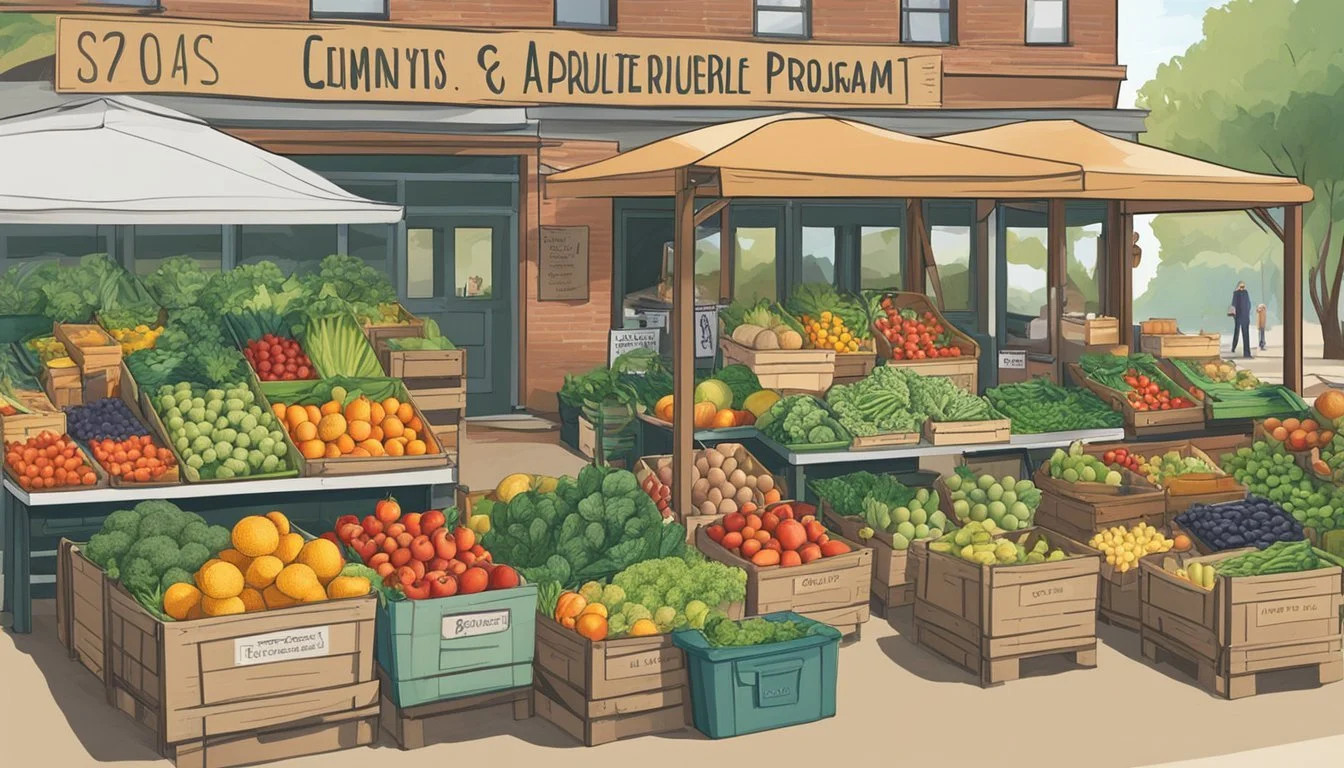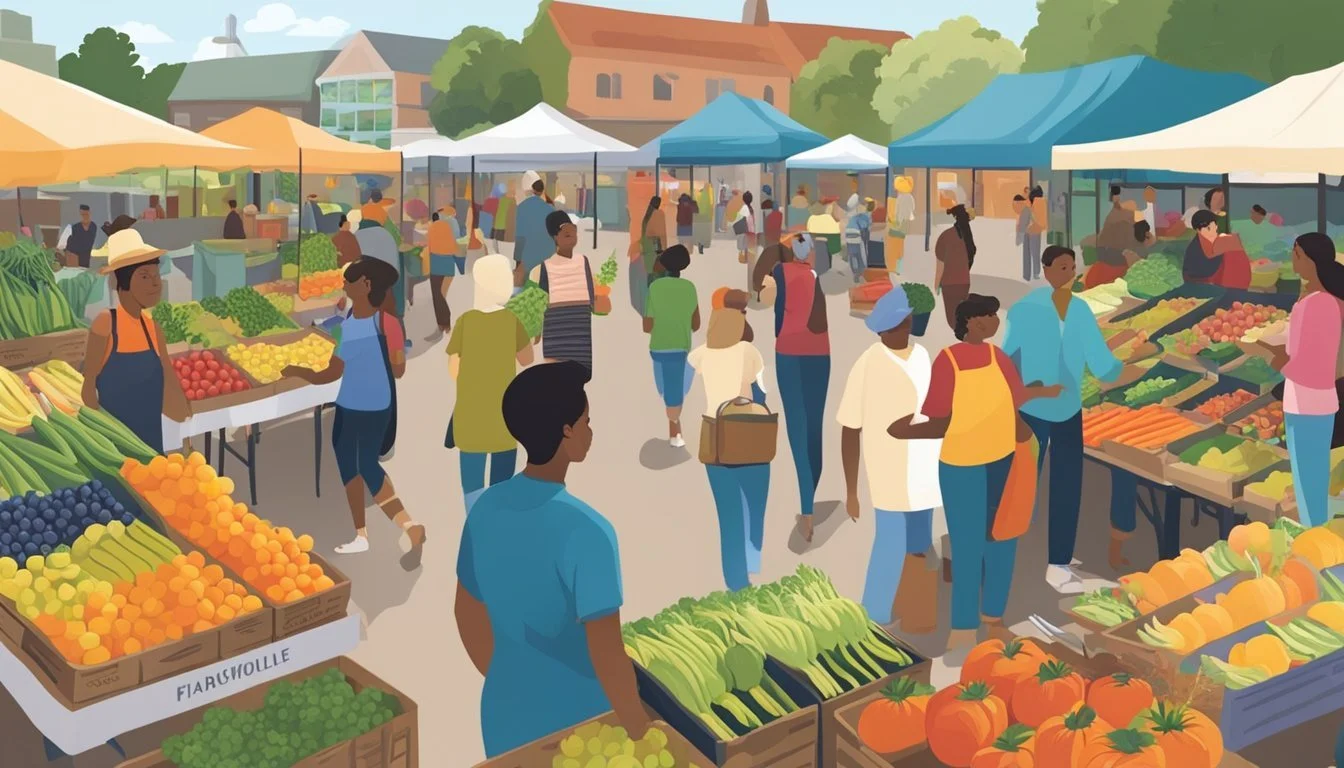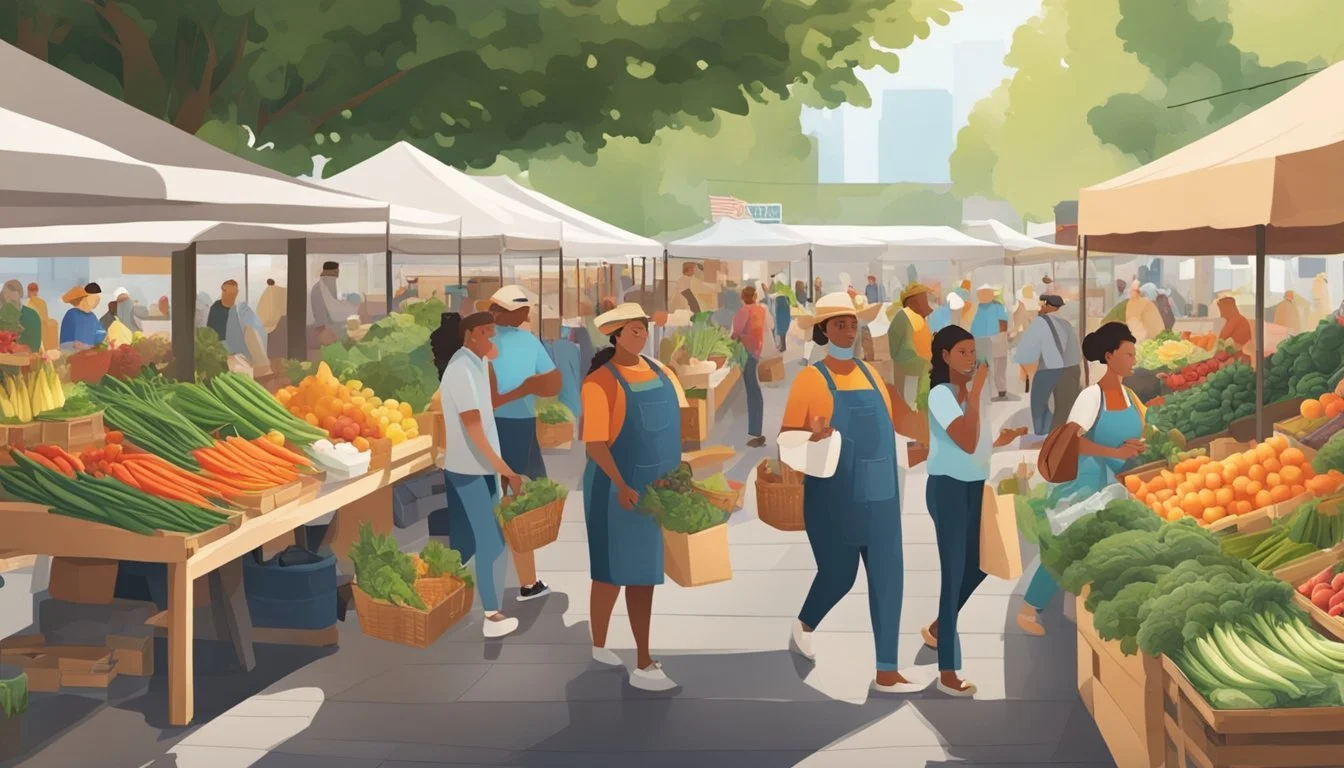How to Create a Community
Supported Agriculture (CSA) Program with Farmers' Market Bounty
Community-Supported Agriculture (CSA) has carved a niche in the food procurement market by offering consumers the opportunity to buy local, seasonal produce directly from farmers. Establishing a CSA requires strategic planning and a robust connection with the local community. CSA members typically pay for a share of the farm's produce in advance, which grants them a regular supply of fresh produce throughout the farming season.
At a Farmers' Market, producers have the added advantage of interacting face-to-face with consumers, which can be leveraged to build a CSA. This direct relationship can foster trust and community engagement; it is an essential component in creating a successful CSA. At these markets, farmers can gauge customer interest, gather feedback, and enlist members for their CSA, thereby ensuring a stable, upfront source of income for the season.
Transitioning from a Farmers' Market to a CSA model involves a paradigm shift from single transactions to a more integrated approach where consumers support the agricultural process. They become shareholders in the farming operation, invested not only financially but also in the ethos of local, sustainable agriculture. Starting a CSA from Farmers' Market produce requires clear communication and transparency to ensure that both farmers and consumers understand the mutual benefits and responsibilities involved in this relationship.
Understanding CSA Fundamentals
In the realm of sustainable food systems, the CSA model stands out for fostering direct partnerships between community consumers and local farmers. These relationships enhance the agricultural economy and ensure fresher produce for members.
Defining CSA
Community-Supported Agriculture (CSA) serves as a collaborative approach where consumers invest in local farms by purchasing shares. These shares represent portions of the farm's output, typically distributed to consumers as weekly produce boxes throughout the farming season.
Benefits of CSA to Consumers and Farmers
Consumers benefit from CSA by receiving regular deliveries of fresh, locally-grown produce, thus ensuring a connection to the source of their food. Farmers, on the other hand, gain financial security from pre-season funding through membership fees, which helps alleviate the risk of crop failures.
CSA Model Overview
The CSA model operates on a pre-paid subscription basis. Consumers purchase shares in advance, which provides the farmer with working capital at the start of the season. Farmers then provide a weekly supply of produce, often including fruits, vegetables, and sometimes other farm products such as eggs or flowers, directly to their members throughout the harvest season. This structure promotes community engagement and supports the local agricultural economy.
Starting a CSA
Starting a Community Supported Agriculture (CSA) initiative requires careful planning and consideration of various key aspects including the development of a solid business plan, understanding budget and payment structures, and effectively sourcing and managing land. Each component plays a critical role in establishing a successful CSA that benefits both local farmers and the community.
Developing a Business Plan
A thorough business plan is essential for any local farmer seeking to establish a CSA. They must outline their objectives, target market, and strategies for marketing their produce. The business plan should also detail the types of crops planned for cultivation, expected yield, and the seasonality of produce offerings. This document serves as a roadmap and can assist in attracting members or investors.
Objectives: Define what the CSA aims to achieve.
Market Analysis: Identify target CSA members and understand community needs.
Marketing Strategies: Determine how to attract and retain members.
Budget and Payment Structures
Understanding and planning the budget is crucial for the financial health of a CSA. Local farmers must account for all costs associated with their CSA, such as seeds, supplies, and labor. After estimating the total expenses, they should add a reasonable profit margin to set the price for each share.
Payment structures can vary:
Lump Sum: Members pay for their share at the beginning of the season.
Installments: Members pay in scheduled payments.
Sourcing and Managing Land
Successful sourcing and management of land are central to launching a CSA. The local farmer must secure a plot suitable for the diverse array of crops they intend to grow. They must also plan for the sustainable management of this land to ensure the longevity and productivity of the CSA.
Land Evaluation: Soil quality, water access, and climate suitability.
Sustainable Practices: Crop rotation, organic methods, and resource conservation.
Each subsection sheds light on critical areas local farmers must navigate in the creation of a CSA, highlighting the operational and logistical considerations imperative to fostering a bountiful and community-supported farm.
Membership and Community Engagement
Creating a sustainable and successful Community-Supported Agriculture (CSA) program hinges on the development of a solid membership foundation and the nurturing of a strong community spirit among its members. Successful engagement strategies ensure that members feel valued and connected, leading to increased support for the CSA.
Determining Membership Model
When establishing a CSA, farmers need to decide on their membership model. This sets the framework for how individuals can join and support the CSA. Options include:
Seasonal Membership: Members pay in advance for a season's worth of produce.
Installment Membership: Payment is split over the course of the delivery period.
Flexible Membership: Offering a range of payment options to attract a broader base of potential members.
Farmers should consider their capacity, demographic targets, and financial requirements when choosing a model.
Recruiting and Retaining Members
Recruitment is crucial for the initial and ongoing success of a CSA. Strategies include:
Marketing Campaigns: Utilizing social media, local markets, and word-of-mouth to inform potential members.
Open Days: Inviting the public to visit and experience the farm firsthand.
Member Benefits: Providing exclusive opportunities such as farm events or workshops.
Retention involves maintaining satisfaction through:
Consistent communication with members via newsletters or direct contacts.
Listening to member feedback and adjusting offerings accordingly.
Ensuring the quality and variety of CSA produce remains high.
Fostering a Sense of Community
A CSA thrives on the sense of community among its members. To develop this:
Host community events like potlucks, workshops or harvest days where members can interact and bond.
Encourage members to volunteer on the farm to deepen their connection to the food they eat.
Create a communication platform, such as a private Facebook group, for members to share recipes, stories, and tips.
By integrating these elements, a farmer can build a vibrant community that actively supports the collaborative success of the CSA.
Product Selection and Farming Practices
Selecting the right products and adhering to appropriate farming practices are pivotal to the success of a Community-Supported Agriculture (CSA) program. This entails a careful balance between crop variety, organic methods, and the mitigation of weather and seasonal impacts.
Choosing Crops and Products
In a CSA model, farmers must consider both the demands of the local community and the environmental conditions of their region. A diverse selection often includes vegetables, fruits, eggs, meat, and flowers to ensure a well-rounded offering. Careful selection of seeds is crucial for yield and quality.
Vegetables/fruits: Tomatoes, cucumbers, peppers, leafy greens, apples, pears;
Proteins: Free-range eggs, pasture-raised poultry or beef;
Additional offerings: Herbs, cut flowers, or specialty items.
Organic and Sustainable Methods
Organic farming underscores the use of natural processes and materials to enrich soil quality and promote biodiversity, eschewing synthetic pesticides and fertilizers. The adoption of sustainable practices such as composting, crop rotation, and natural pest control contributes to the health of the farm ecosystem.
Sustainable Practices:
Crop Rotation: Improves soil health and reduces pests/diseases;
Composting: Enhances soil fertility using organic waste;
Natural Pest Control: Employs beneficial insects or planting deterrents instead of chemicals.
Handling Weather and Seasonal Challenges
Resilience against unpredictable weather patterns and seasonal fluctuations is vital for a CSA. Farmers may use protective structures like greenhouses or high tunnels to shield produce. Additionally, developing a robust planting schedule aligned with climate patterns enables a consistent supply of local food.
Summer: Shade cloths and irrigation systems combat excessive heat/drought;
Winter: Greenhouses, cold frames, or choosing cold-hardy crops can extend the season.
By incorporating a broad array of crops and adhering to organic and sustainable farming practices, CSA farmers can deliver fresh, local products while fostering a resilient agricultural system.
Operational Logistics
The successful operation of a CSA hinges on efficient management of harvest schedules, labor, and the delivery systems to distribute fresh produce to members.
Managing Harvest and Labor
Harvesting for a CSA requires precise planning to meet the share commitments for each distribution. Farmers must calculate the labor needed for picking, packing, and preparing produce. Labor typically includes a mixture of skilled workers for crop planning and harvesting, as well as less skilled laborers for tasks like washing and packing produce. They often schedule more intensive labor around peak harvest times to ensure that produce is fresh.
Distribution and Delivery Systems
The distribution system is crucial for a CSA to function effectively. This involves setting up designated pickup locations or delivering directly to customers. A common practice includes organizing distribution hubs at farmers' markets or local community centers. As for the delivery system, it can range from self-service at the farm or drop sites to home delivery, which requires additional logistics planning and costs.
Pickup Times: Usually communicated well in advance and aligned with harvest times.
Delivery: May include additional fees and should guarantee the freshness upon arrival.
Share Sizes and Pickup/Delivery Options
CSA members can typically choose from various share sizes, depending on their needs. It is common to offer small, medium, and large shares corresponding to the size of the household or appetite.
Small share: Suitable for 1-2 people
Medium share: Ideal for a small family
Large share: Designed to feed a larger family or those who consume more vegetables
Both pickup and delivery options must be clear to members:
Pickup: At a fixed time and location, usually once a week.
Delivery: Potentially more flexible but may incur additional costs.
Marketing and Community Outreach
For a CSA to thrive, effective marketing and community outreach are crucial. They facilitate a direct connection between farmers and the local community, ensuring consistent support for local agriculture.
Creating Effective Marketing Materials
Marketing materials are the first contact point a consumer has with a CSA. They should include clear information about the CSA’s offerings, subscription details, and pickup locations. High-quality, visually appealing brochures, flyers, and posters can be placed at strategic locations like local businesses, farmers markets, and community centers to capture potential members' attention. This tangible form of advertising should:
Emphasize freshness and quality of the produce.
Outline the benefits of joining the CSA.
Provide testimonials from satisfied CSA members.
Utilizing Social Media and Newsletters
Social media platforms offer an inexpensive and effective way to reach a broad audience. A CSA can leverage these platforms to showcase the produce, share recipes, and engage with the community through regular updates. An engaging social media strategy might include:
Weekly "Featured Produce" posts.
Live Q&A sessions with the farmers.
User-generated content, like recipes from members, using a #CSAMembers hashtag.
A newsletter can deepen relationships with current members by providing regular updates about the farm's status, upcoming produce availability, and members-only events. Newsletters should be concise, visually engaging, and include:
Upcoming events or changes in distribution schedule.
Spotlights on seasonal produce or new additions to the CSA.
Building Relationships with Local Food Banks and Markets
Creating partnerships with local food banks can not only help to support those in need but also raise the CSA's profile as a community-conscious organization. They can provide excess produce to food banks, establishing a reputation for community support and possibly attracting new members who value social responsibility.
Forming relationships with local markets can enhance the CSA’s visibility. A presence in farmers markets allows the CSA to sell individual items and promote share subscriptions directly. CSAs can offer:
Sampling events at farmers markets to showcase the quality of the produce.
Flyers with a QR code to sign up for the newsletter or learn more about the CSA membership.
Risk Management and Sustainability
Creating a Community-Supported Agriculture (CSA) involves careful planning to manage risks and ensure the sustainability of the project. The farmers and community members share the risks and benefits, making it crucial to address potential challenges such as crop failure and surplus production. Equally important are considerations of insurance and liability to protect both the farmers and their consumers. To guarantee longevity, farmers must also focus on strategies for long-term viability and diversification of crops and products.
Dealing with Crop Failure and Surplus
Shared Risk: A fundamental aspect of CSA is the shared risk between farmers and consumers. When crop failure occurs, the impact is absorbed by the entire community, reducing the financial burden on the farmer. Transparency about potential risks and proactive communication is essential to maintaining trust among members.
Refund Policy: Establishing a clear policy regarding refunds or alternative compensations helps manage consumer expectations and maintains fairness in the event of crop failure.
Managing Surplus: Surplus produce can be handled through:
Donation to local food banks or charitable organizations.
Offering additional shares to members or one-time purchases to non-members.
Creating value-added products, like jams or pickles, to extend the produce's shelf life and profitability.
Insurance and Liability Considerations
Investing in comprehensive insurance policies is non-negotiable to protect the CSA from natural disasters, accidents, or other unforeseen events.
Farmers should consider coverage for:
Product liability
Property damage
Worker's compensation (if employees are involved)
Liability waivers can also be a tool for CSAs. Members who sign waivers acknowledge the inherent risks involved in farming and agree not to hold the CSA responsible for certain losses.
Long-term Viability and Diversification
Investment in the CSA's future is vital for its longevity. This can be achieved through:
Crop Diversification: Planting a variety of crops can mitigate the impact of crop failure and attract a wider customer base.
Expanding product offerings to include non-produce items, such as dairy, eggs, or meat from local producers.
Community engagement initiatives to strengthen customer loyalty and support.
Working towards sustainability means balancing current operations with forward-thinking practices to ensure the CSA thrives for years to come.
Enhancing Member Experience
To elevate the community-supported agriculture (CSA) member experience, it is crucial to offer more than just fresh produce. Benefits such as culinary education, on-farm experiences, and consistent feedback channels add significant value to membership.
Providing Recipes and Cooking Tips
Members look forward to turning their fresh, seasonal produce into delicious meals. CSAs can enhance this aspect by:
Including recipe cards with each produce share, tailored to the week's harvest.
Hosting online platforms where cooking tips and videos are shared, encouraging members to try new dishes and cooking techniques.
Offering Farm Visits and Events
CSAs can foster a direct connection between the farm and its patrons. Key initiatives include:
Organizing farm visit days, where members can tour the fields and learn about farming practices firsthand.
Hosting community events such as harvest festivals or potlucks, which not only educate but also strengthen the communal network.
Creating a Feedback Loop
A successful CSA relies on member input to grow and adapt. A robust feedback system can involve:
Surveys to gauge member satisfaction and suggestions for improvement.
Encouraging open dialogues through seasonal meetings or a dedicated community platform for suggestions and concerns.








